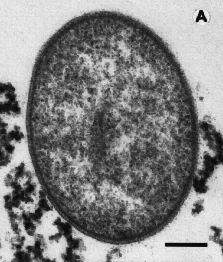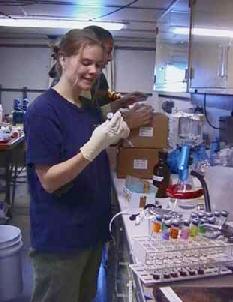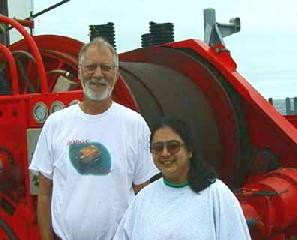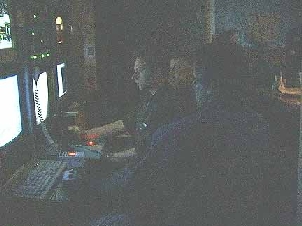WHAT'S NEW:
BACKGROUND:
Mission
Project Description
Cruise Plans:
Participants
Technology (ROV, ships, etc.)
Future Plans
Results:
1998 NeMO Cruise
Axial 1998 "Eruption"
Logbook
July 5, 1999
July 5, 1999
Contents:
- News from Thompson
- Participant Perspective
- Logbook from Teacher at Sea
- Question/Answer from shore to sea
Thompson Science Report
Science update:
Not wanting to slight the little guys, in this case microbes, we wanted to highlight one of the other new breakthroughs on this cruise...
Hunting for High Temperature Microbes
Julie Huber  One of the best
things about being a hydrothermal vent microbiologist is hunting for exciting
microbes (photo right) that push the limits of life by surviving at
environmental extremes such as high temperature and pressure. Our
lab at the University of Washington,
headed up by Dr.
John Baross, is always in search of high temperature microorganisms,
referred to as hyperthermophilic archaea. These are the most heat-loving
of all known microorganisms, and all have temperature optima above 80
C. Because the surface of early Earth was likely much hotter than it is
now, many scientists believe that these hyperthermophiles may have
been the earliest life forms on earth. By studying these microbes,
then, we can peer into the past, as well as into the possibility of
life in the subsurface biosphere existing below the seafloor. The
hard part, though, is catching the bugs. It takes a lot of luck to hunt
them down, but a little preparation doesn't hurt either.
One of the best
things about being a hydrothermal vent microbiologist is hunting for exciting
microbes (photo right) that push the limits of life by surviving at
environmental extremes such as high temperature and pressure. Our
lab at the University of Washington,
headed up by Dr.
John Baross, is always in search of high temperature microorganisms,
referred to as hyperthermophilic archaea. These are the most heat-loving
of all known microorganisms, and all have temperature optima above 80
C. Because the surface of early Earth was likely much hotter than it is
now, many scientists believe that these hyperthermophiles may have
been the earliest life forms on earth. By studying these microbes,
then, we can peer into the past, as well as into the possibility of
life in the subsurface biosphere existing below the seafloor. The
hard part, though, is catching the bugs. It takes a lot of luck to hunt
them down, but a little preparation doesn't hurt either.
 Before
going to sea, I mixed up a wide array of nutritional media to try to mimic
the natural environment of the subsurface seafloor. Because most high
temperature archaea have been found to metabolize sulfur in some way,
much of our media collection includes elemental sulfur, which is formed
from geothermal hydrogen sulfide (see
discussion in today's perspective). Additionally, most of these hyperthermophiles
are obligate anaerobes, meaning they cannot grow in the presence of oxygen.
When a sample comes on deck from the volcanic fluids from Axial, we inject
some of this fluid into our anaerobic test tubes, careful to avoid any
contamination by oxygen or other substances that may prove deadly to these
microbes. We then place our tubes in incubator ovens set at different
temperatures. (photo left) We commonly culture microbes at 55 C (referred
to as thermophiles) and 90 C (hyperthermophiles). Every once in awhile,
though, we try to push the temperature limit by incubating above 100 C.
Currently, the highest known upper temperature limit for growth of a living
organism is 113 C by a sulfur-dependent hyperthermophilic Archaea called
Pyrolobus.
Before
going to sea, I mixed up a wide array of nutritional media to try to mimic
the natural environment of the subsurface seafloor. Because most high
temperature archaea have been found to metabolize sulfur in some way,
much of our media collection includes elemental sulfur, which is formed
from geothermal hydrogen sulfide (see
discussion in today's perspective). Additionally, most of these hyperthermophiles
are obligate anaerobes, meaning they cannot grow in the presence of oxygen.
When a sample comes on deck from the volcanic fluids from Axial, we inject
some of this fluid into our anaerobic test tubes, careful to avoid any
contamination by oxygen or other substances that may prove deadly to these
microbes. We then place our tubes in incubator ovens set at different
temperatures. (photo left) We commonly culture microbes at 55 C (referred
to as thermophiles) and 90 C (hyperthermophiles). Every once in awhile,
though, we try to push the temperature limit by incubating above 100 C.
Currently, the highest known upper temperature limit for growth of a living
organism is 113 C by a sulfur-dependent hyperthermophilic Archaea called
Pyrolobus.
Two weeks ago, we got very lucky in our little ship-bound lab and managed to find a positive culture tube happily growing above 100 C. This microbe, growing anaerobically with elemental sulfur, was isolated from ~70 C fluid at Marker 33, a well-studied site on the new lava flow here at Axial. The fact that we have found a microbe (or group of microbes) growing at such a high temperature, yet isolated from fluids much below its temperature of growth, strongly suggests that there is a hotter subsurface environment that these microorganisms are growing and thriving in, perhaps hundreds of meters below the seafloor. It is not until a perturbation to the system occurs that these fluids make it to the seafloor, though, so the recent eruption here at Axial makes it an ideal study site for collecting these fluids and searching for subsurface microorganisms. By studying this exciting microbe, we hope to learn more about the metabolic wonders of life at high temperature and what limits life. Additionally, we will gain important clues about the deep subsurface and early environments here on earth, perhaps allowing us to speculate beyond our own planet to the possibility of life on other planets and moons. The hunt continues...
Listing of all Science News postings
Life at Sea: Participant Perspective
Steve Scott and Naaznin Pastakia
University of Toronto

Naaznin Pastakia and Steve Scott are geologists from the
University of
Toronto
Naaznin:
Naaznin, who comes from
Bombay,
India, is working on her MSc thesis under the direction of two profs at
Toronto (so double-trouble!), Steve and his colleague Grant Ferris, a
biogeochemist specializing in metal precipitating bacteria.
Naaznin's research involves the role of bacteria in precipitating solids.
This process, called "biomineralization" is happening at Axial Volcano.
Bacteria in low temperature vents are concentrating mainly iron and silica
from the vent fluids onto their bodies. The iron is a semi-amorphous
oxyhydroxide called ferrihydrite (Fe5HO8.4H2O). On the seafloor, it looks
like
fluffy red stuff sitting in cracks and fissures on the surface of the
rocks and, in places, forms small mounds several centimeters high.
Naaznin is characterizing the composition and mineralogy of this
ferrihydrite. Analyses show that, besides iron and silica, ferrihydrite
also contains various other elements in minor (Mn, Mg, P) to trace (Ni,
Ba, Cu, Zn) amounts. In some ancient lava flows, bright red iron-rich
chert fills cracks and spaces around the pillows (pillows are bun shaped
features that are common in many lavas). Naaznin is attempting to
determine if the origin of this chert is the "fluffy red stuff" that we
are seeing so commonly at Axial Volcano.
Steve:
Steve is the Director of the
Scotiabank Marine Geology Research Laboratory.
He started rather late in the
marine business. "I spent the first 14 years since the completion of my
PhD at
Penn State University synthesizing metallic sulfide minerals and
trying to figure out how metallic ores formed", says Steve. "When I saw a
photo of a black smoker in
National Geographic magazine in 1979, I just
knew that some of the answers I was seeking were to be found in the
oceans." We had already understood that a particular kind of ore deposit
containing copper, zinc, lead, silver and gold formed on the ocean floor
but we were not sure of the process. Our marine studies, including those
at Axial Volcano, have demonstrated conclusively that
the minerals are
precipitated as metal sulfides from hot water that is spewed out onto the
sea floor through chimney-like structures. The
black billowing hot fluid
looks like smoke coming out of a stack in a dirty industrial process,
hence the term "black smoker". By studying modern analogs in todays
oceans, we've learned a lot about how ancient ores formed as long as 2.7
billion (yes, billion) years ago. It is also just dawning on us that some
of the seafloor deposits may be an economic resource themselves. The
deposits at Axial Volcano are far too small to be economic, even though
they are quite gold rich, but we know of other deposits that are as big as
mines on land.
Biomineralization is another thing that excites Steve. "It amazes me to
think that such tiny creatures as bacteria can concentrate such large
quantities of metals and other elements", says Steve. Given enough time,
can they create ore bodies? Can we use bacteria to remove pollutants from
water just like the bacteria around hydrothermal vents at Axial Volcano
are detoxifying their environment? Answers to these and other questions
may come out of Naaznins and Steves research.
Steve was one of three founders of the Canadian Scientific Submersible Facility that manages and operates the ROPOS remotely operated vehicle we are using in the NeMO program. "I drew the short straw and was made President", jokes Steve. Kim Juniper, who is also out here on NeMO, is the Secretary-Treasurer. The founders of the not-for-profit CSSF corporation are all academics who knew nothing about running a business but have learned fast. It is a lot of work but is necessary if the scientific community, of which Steve and Kim are a part, is to maintain access to this incredible machine that is our vehicle to inner space on the seafloor.
Listing of all Perspectives postings
Teacher At Sea Logbook
Teacher Log #15 7/5/99
Its turning out to be a great day on the Pacific. When my alarm went off this morning the first thing I noticed was an absence of movement. I stepped out onto the weather deck and saw that the water was calmer than any day weve had so far. The wind was blowing under 5 knots and the sky was cloudy with a few patches of blue to allow some morning light to color the ocean surface. Often we are all so busy out here that we don't get out on deck to observe the day, especially when ROPOS is in the water. Dive 495 is still in progress after over 15 hours. The hot fluid sampler is working great and the sea purse, attached for rock collecting, is already full.
The last few days I've talked about the ROPOS lab, indicating it as "the place
to be." When a dive is in progress it takes a minimum of seven people
to perform all of the functions, but there may be as many as 15
people crowding around to watch the action.  Sitting up in front of the room in the pilot's chair can be any one of
the ROPOS technicians (photo right). Some fly the ROV more than others,
but each one does have the opportunity. Sitting to the right of the pilot
is the co-pilot/navigator/arm manipulator. This person is the one who
so delicately positions instruments and samplers. Viewing a two dimensional
video screen, he must somehow find the right range and depth needed to
complete specialized tasks using the seven function arm. The third technician
is in and out of the room doing the odd jobs necessary that go unnoticed
by the preoccupied scientists and viewers. Fixing a computer at one station,
reconnecting a video line, checking the angle of the cable or fixing a
broken instrument for future dives are just a few of the chores needing
his attention. The ROPOS crew works
in 12-hour shifts 12 hours on and 12 hours off.
Sitting up in front of the room in the pilot's chair can be any one of
the ROPOS technicians (photo right). Some fly the ROV more than others,
but each one does have the opportunity. Sitting to the right of the pilot
is the co-pilot/navigator/arm manipulator. This person is the one who
so delicately positions instruments and samplers. Viewing a two dimensional
video screen, he must somehow find the right range and depth needed to
complete specialized tasks using the seven function arm. The third technician
is in and out of the room doing the odd jobs necessary that go unnoticed
by the preoccupied scientists and viewers. Fixing a computer at one station,
reconnecting a video line, checking the angle of the cable or fixing a
broken instrument for future dives are just a few of the chores needing
his attention. The ROPOS crew works
in 12-hour shifts 12 hours on and 12 hours off.
Sitting to the left of the pilot is one of the lead scientists selected for the dive. Chosen for his or her knowledge of the specific task at hand, the principal investigator (PI) will direct the pilot as to what goals need to be completed. Besides directing what samples and/or equipment to use, the PI also may take pictures of the site under investigation. The Silicon Intensified Target camera (SIT) takes excellent images of where we are and what is going on. In the second row, positioned around the large workstation in the center of the lab, are the frame grabber, data logger, and the navigators. One of my duties is as a frame grabber. Digital images can be selected from the video display and stored and logged in the computer for future reference. All of the underwater images youve seen of the ocean floor were acquired in this manner. Next to the frame grabber sits the data logger. The data logger is responsible for making note of all that is happening during the dive. On the other side of the data logger is the navigator. The navigator is responsible for knowing the location of ROPOS, the cage, and the ship in relation to the vent site and its real position in the world. And last but not least, sitting in the back corner is the videotape manager. This may sound like one of the easier jobs, but there is a stack of six tape machines and several are turned on and off during the highlights of the dive. Each of these positions is equally as important and are being performed in four hour shifts, around the clock.
Along with all of the required positions, the room is also filled
with scientists watching the action on one of the six video monitors
around the room. The lab gets quite crowded and noisy sometimes but nobody
seems to mind. It is a productive scientific atmosphere where people from
different backgrounds offer their perspective in discussions about the
significance of what they are seeing. A successful dive brightens the
spirits, gets everyones energies going, and adds to the good feeling that
an important job is being done.
Bye for now.
Logbook of all Teacher At Sea postings
Questions & Answers
(oar.pmel.vents.webmaster@noaa.gov)